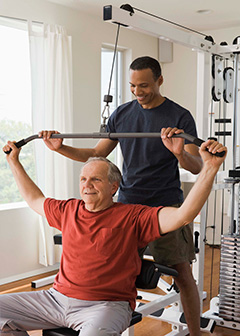How to Become a Fitness Trainer or Instructor About this section

Personal trainers work one-on-one or with two or three clients, either in a gym or in the client’s home.
The education and training required for fitness trainers and instructors vary by type of specialty, and employers often hire those with certification. Personal fitness trainers, group fitness instructors, and specialized fitness instructors each need different preparation. Requirements vary by facility.
Personal fitness trainers often start out by taking classes to become certified. Then they work alongside an experienced trainer before being allowed to train clients alone.
Many group fitness instructors often take training and become certified, and then they must audition for instructor positions. If they succeed at the audition, they may begin teaching classes.
Training for specialized fitness instructors can vary greatly. For example, the duration of programs for yoga instructors can range from a few days to more than 2 years. The Yoga Alliance has training standards requiring at least 200 hours with a specified number of hours in techniques, teaching methods, anatomy, physiology, philosophy, and other areas.
Certification
Employers prefer to hire certified fitness trainers and instructors. Personal trainers are often required to be certified to begin working with clients or with members of a gym or other type of health club. Group fitness instructors may be allowed to begin without certification, but employers often encourage or require them to become certified.
Most trainers or instructors need certification in cardiopulmonary resuscitation (CPR) before applying for certification in physical fitness.
Many organizations offer certification. The National Commission for Certifying Agencies (NCCA), part of the Institute for Credentialing Excellence, lists certifying organizations that are accredited.
All certification exams have a written part, and some also have a practical part. The exams measure the candidate’s knowledge of human physiology, understanding of proper exercise techniques, assessment of clients' fitness levels, and development of appropriate exercise programs.
No specific education or training is required for certification. Many certifying organizations offer study materials, including books, CDs, other audio and visual materials, and exam preparation workshops and seminars.
Advanced certification requires an associate’s or bachelor's degree in an exercise-related subject that presents more specialized instruction, such as training athletes, working with people who are injured or ill, or advising clients on general health.
Education
Almost all trainers and instructors have at least a high school diploma before entering the occupation. An increasing number of employers require fitness workers to have an associate’s or bachelor’s degree related to a health or fitness field, such as exercise science, kinesiology, or physical education. Programs often include courses in nutrition, exercise techniques, and group fitness.
Important Qualities
Customer-service skills. Many fitness trainers and instructors must sell their services, motivating clients to hire them as personal trainers or to sign up for the classes they lead. Therefore, fitness trainers and instructors must be polite, friendly, and encouraging to get and keep their clients.
Listening skills. Fitness trainers and instructors must be able to listen carefully to what clients tell them to determine the client's fitness levels and desired fitness goals.
Motivational skills. Getting fit and staying fit takes a lot of work for many clients. To keep clients coming back for more classes or to continue personal training, fitness trainers and instructors must be able to keep their clients motivated.
Physical fitness. Fitness trainers and instructors need to be physically fit because their job requires a considerable amount of exercise. Group instructors often participate in classes, and personal trainers often need to show exercises to their clients.
Problem-solving skills. Fitness trainers and instructors must evaluate each client’s level of fitness and create an appropriate fitness plan to meet the client’s individual needs.
Speaking skills. Fitness trainers and instructors must be able to communicate well because they need to be able to explain exercises and movements to clients, as well as motivate them verbally during exercises.
Advancement
Fitness trainers and instructors who are interested in management positions should get a bachelor's degree in exercise science, physical education, kinesiology, or a related area. Experience is often required to advance to management positions in a health club or fitness center. Some organizations require a master's degree.
Personal trainers may eventually advance to a head trainer position and become responsible for hiring and overseeing the personal training staff or for bringing in new personal training clients. Some fitness trainers and instructors go into business for themselves and open their own fitness centers. Group fitness instructors may be promoted to group exercise director, a position responsible for hiring instructors and coordinating exercise classes. Trainers and instructors may eventually become a fitness director or general manager.









